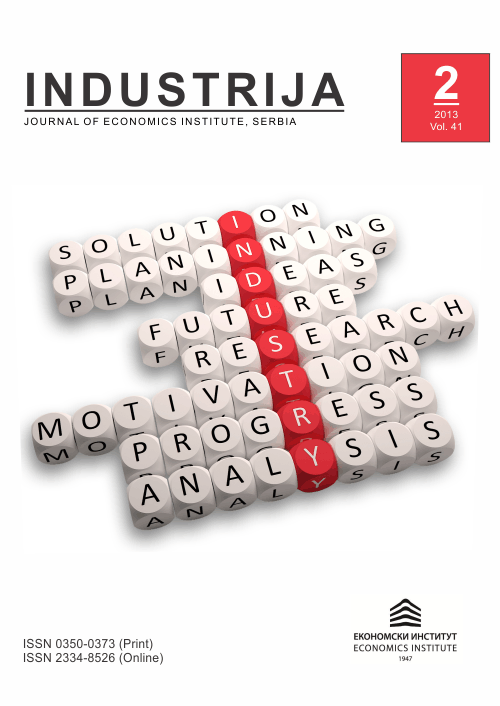A Mystery of the Global Surplus and its Ramification
Abstract
This paper deals with phenomenon of the increasingly indicative global imbalances and lagging genesis of balance of payments (BoP) accounting in an attempt to accommodate the ongoing mutation of international trade and finance. Namely, although BoP of the world as a whole should be zero since international trade in goods, services and financial assets ought to be a zero-sum game, our planet apparently runs a non-negligible and rising BoP surplus, projected to reach 1% of global GDP by 2015! To make the puzzle more bizarre, IMF statistics up until 2004 had recorded a persistent BoP deficit for the entire globe, which P. Krugman dubbed “The Mystery of the missing Surplus”. Well, surplus is back with the vengeance – while this paper tries to make sense of the phenomenon and pinpoint both its determinants and likely economic consequences. In conclusion, it appears that 1) during international financial crises quality and accuracy of the BoP statistics worsens worldwide, 2) net global imbalances may still be much smaller than we commonly believe, 3) true culprits may not be our usual suspects, 4) gross trade exhibits stark differences once confronted with decomposed value-added net exports and imports free of double counted processed exports and indirect exporting, 5) also, deliberate misreporting of cross-border investment proceeds as well as MNE’s transfer pricing practices may account for a relevant portion of registered global imbalances, and finally, 6) even the latest 6th edition of the IMF’s BoP and IIP Manual explicitly tackles but a few of the factors behind the returning surplus mystery.
References
• Bems, R.-Johnson, R. (2012), “Value-Added Exchange Rates”, NBER Working Paper 18498, Cambridge, MA.
• Blanchard, O. (2007), “Global Imbalances”, Mexico City Lecture, mimeo.
• Bordo, M. (2005), “Historical Perspective on Global Imbalances”, NBER Working Paper 11383, Cambridge, MA.
• Borio, C.-Disyatat, P. (2011), “Global Imbalances and Financial Crisis: Link or No Link?”, BIS Working Paper No. 346, Monetary and Economis Department, Bank for International Settlements, Basel.
• Brender, A.-Pisani, F. (2010), “Global Imbalances and the Collapse of Globalized Finance”, Centre for European Policy Studies and Dexia Bank, Brussels.
• Caballero, R.-Farhi, E.-Gourinchas, P.-O. (2008), “An Equilibrium Model of ‘Global Imbalances’ and Low Interest Rates”, American Economic Review #98:1, pp. 358-393, February.
• Chinn, M.-Eichengreen, B.- Ito, H. (2011), „Forensic Analysis of Global Imbalances“, NBER Working Paper 17513, Cambridge, MA.
• Dunaway, S. (2009), “Global Imbalances and the Financial Crisis”, Council’s Special Report No. 44, Council on Foreign Relations, Center for Geoeconomic Studies, New York, NY.
• The Economist (2011), “Global Imbalances”, printed issue, January 27th, mimeo.
• The Economist (2011*), “Economics Focus: Exports to Mars”, printed issue, November 12th, mimeo.
• The Economist (2012), “Global Imbalances: The Black Hole”, printed issue, April 26th, mimeo.
• Gagnon, J. (2011), “Current Account Imbalances Coming Back”, Peterson Institute for International Economics and Asian Development Bank, Working Paper 11-1, Washington, DC.
• Gagnon, J. (2012), “Global Imbalances and Foreign Asset Expansion by Developing-Economy Central Banks”, Peterson Institute for International Economics, Working Paper 12-5, Washington, DC.
• IMF (2004), “Committee on Balance of Payments Statistics – Annual Report 2004”, International Monetary Fund, Washington, DC.
• IMF (2005), “Committee on Balance of Payments Statistics – Annual Report 2005”, International Monetary Fund, Washington, DC.
• IMF (2009), “Balance of Payments and International Investment Position Manual”, Sixth Edition, International Monetary Fund, Washington, DC.
• IMF (2010), “Committee on Balance of Payments Statistics – Annual Report 2010”, International Monetary Fund, Washington, DC.
• IMF (2011), “Committee on Balance of Payments Statistics – Annual Report 2011”, International Monetary Fund, Washington, DC.
• IMF (2012), “World Economic Outlook”, International Monetary Fund, Washington, DC, October.
• Johnson, R.-Noguera, G. (2011), “Proximity and Production Fragmentation”, Paper prepared for the 2012 AEA Meeting, mimeo.
• Johnson, R.-Noguera, G. (2012), “Fragmentation and Trade in Value Added over Four Decades”, NBER Working Paper 18186, Cambridge, MA.
• Koopman, R.-Wang, Z.-Wei, S.-J. (2012), “Tracing Value-Added and Double Counting in Gross Exports”, NBER Working Paper 18597, Cambridge, MA.
• Krugman, P. – Obstfeld, M. (2000), “International Economics – Theory and Policy”, Fifth Edition, Addison-Wesley Publishing Company.
• McKinnon, R. (2006), "China's Exchange Rate Trap: Japan Redux?”, American Economic Review, #96, pp. 427–431, February.
• Motala, J. (1997), “Statistical Discrepances in the World Current Account”, Finance & Development, March.
• Obstfeld, M. (2012), “The Current Account and Global Financial Markets”, Presentation at IMF’s Conference on “Analyzing (External) Imbalances”, International Monetary Fund, Washington, DC, February 2nd, mimeo.
• Reinhart, C.-Rogoff, K. (2009), “This Time is Different-Eight Centuries of Financial Folly”, Princeton University Press, Princeton and Oxford, pp.209-211.
• Song, Z.-Storesletten, K.-Zilibotti, F. (2011), “Growing like China”, American Economic Review #101, pp: 202-241, February.
• Wheatley, A. (2013), “China’s Trade Surplus with U.S. may be a Quarter smaller”, Reuters, January 16th, mimeo.

